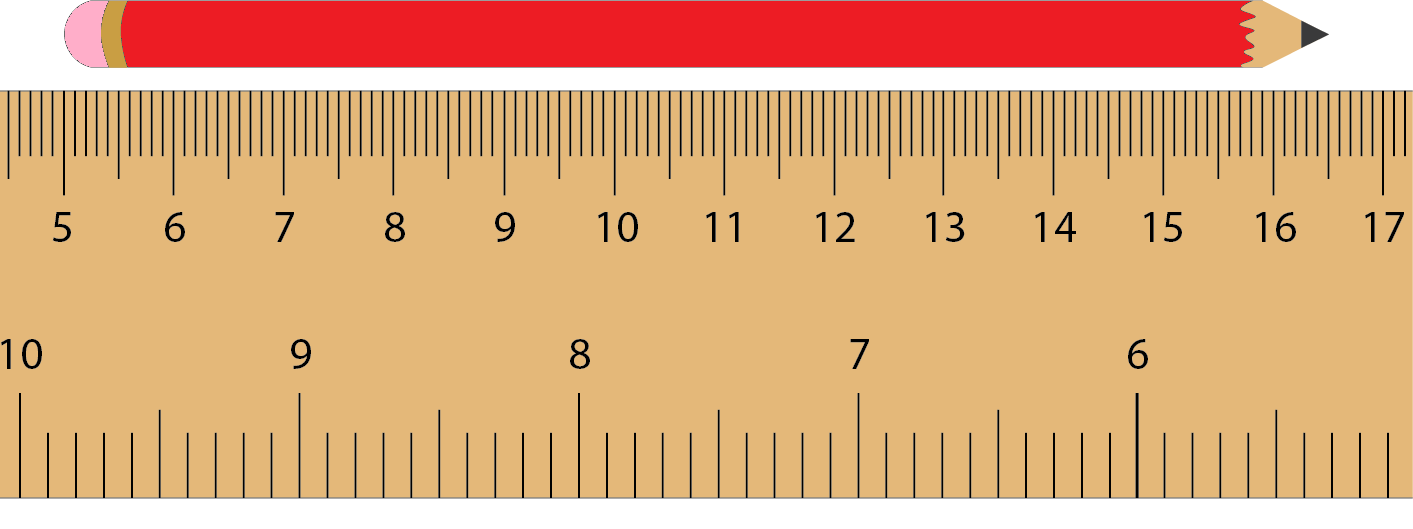The purpose of this activity is to support students making accurate measurements of length by either using zero as a baseline, or by adjusting the measurement when zero is not used as the baseline.
- Objects suitable for measuring length in centimetres, such as pencils, crayons, or feet. These could be reflective of a context that is relevant to your students' cultural backgrounds, interests, and learning from other curriculum areas.
- Rulers
Introduce an object to be measured. Throughout this activity, a pencil is used as this object. Align the beginning of the pencil with a non-zero mark on the ruler.
How long is the pencil? How do you know?
Some students may believe that 21 cm is a reasonable answer since the endpoint aligns with the 21 mark on the ruler. Others might notice that the beginning of the pencil is not aligned with the zero mark on the ruler.
- How could we improve our measurement of the pencil?
One suggestion might be to move the beginning of the pencil to align with zero. If this is not suggested by students, use a think aloud to suggest the idea (e.g. I wonder what would happen if I moved the pencil to line up with where zero is on the ruler?)
Confirm that the pencil is 16 cm long, then return the pencil to its previous position (aligned with the 5 cm mark).
Can we still measure the pencil even though the beginning of it is lined up with the 5 cm mark on the ruler?
As students suggest ideas, record them using language, symbols, and diagrams on a shared display. Two likely ideas are:- Solve 5 + □ = 21, that is add on from five to reach 21 cm.
- Solve 21 – 5 = □, that is remove the unused 5cm from 21 cm.

- Confirm that both methods give an unknown length of 16 cm which matches the correct measurement.
- Pose similar problems by aligning the beginning of different pencils with different baseline marks on the ruler (e.g. with 5 cm, 2 cm, or 4 cm). You might set these up as stations for students to attend to, or you might have the students sit in a large circle and measure a pencil before passing it to their neighbour. After all students have measured all of the pencils, you could ask pairs of students to share their answers and strategies used with each other, and then provide time for students to share their mathematical ideas with the wider class. Consider what groupings and level of independence will best scaffold and extend your students. Other students might benefit from further teacher support.
- Look for students to compensate for the different baselines, make the correct calculations using addition or subtraction, and establish the correct length of each pencil.



Next steps
- Provide the students with broken rulers to use. These can be created by photocopying several standard 30 cm rulers, cutting them into separate rulers, and then cutting off the endpoint of each ruler at a different mark. Ask students to use the broken ruler to measure the length of several objects.

- Extend students’ understanding of the linear scale by asking them to measure lengths that are longer than one ruler. For example, they might measure another student’s height with a 30cm ruler, or the width of their desk or the door. You might ask them to measure the length of the classroom with a one metre ruler using centimetres. Are students able to track the number of centimetres as the ruler is moved?
- Extend students' understand of the linear scale by extending measurements to centimetres and metres. Look for students to use the marks on different measurement tools to identify mm, cm, and m metres, as opposed to solely relying on place value and conversion "rules".